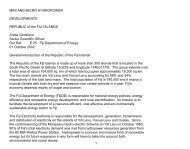SHP-based Rural Electrification in China - Hangzhou Regional ...
SHP-based Rural Electrification in China - Hangzhou Regional ...
SHP-based Rural Electrification in China - Hangzhou Regional ...
You also want an ePaper? Increase the reach of your titles
YUMPU automatically turns print PDFs into web optimized ePapers that Google loves.
<strong>SHP</strong> Development and Programme Worldwide<br />
policies, socio-economic concerns, environmental<br />
concerns.<br />
The high <strong>in</strong>itial capital cost of <strong>SHP</strong><br />
schemes acts as a major impediment to<br />
<strong>SHP</strong> development <strong>in</strong> SEA where fund<strong>in</strong>g<br />
problems are most acute. The issue of<br />
distance between the hydro energy resource<br />
and the load centers, as <strong>in</strong> the<br />
case of Thailand and the Philipp<strong>in</strong>es,<br />
poses difficulties for <strong>SHP</strong> development.<br />
Project cost<strong>in</strong>g varies with the site, the<br />
size and the type of application. The specific<br />
<strong>in</strong>vestment cost per kW of <strong>SHP</strong><br />
project also varies greatly from country<br />
to country, ragn<strong>in</strong>g from US$600/kW to<br />
US$4,000-6,000/kW. Further, the<br />
pre<strong>in</strong>vestment work—site survey and<br />
feasibility study—is higher for <strong>SHP</strong> <strong>in</strong><br />
percentage of the ultimate <strong>in</strong>vestment than<br />
large hydro. Usually, the cost of pre-<strong>in</strong>vestment<br />
work for <strong>SHP</strong> could be higher<br />
than the acceptable 10-15% of total<br />
<strong>in</strong>vestment, even if they are supported<br />
by government or foreign aid.<br />
Attention has been paid to the tra<strong>in</strong><strong>in</strong>g<br />
and technology transfer <strong>in</strong> some SEA<br />
countries dur<strong>in</strong>g the last two decades,<br />
which enables them to master a great<br />
portion of work <strong>in</strong> <strong>SHP</strong> development. Although<br />
several countries have set up<br />
their own capabilities <strong>in</strong> <strong>SHP</strong><br />
development, <strong>in</strong>clud<strong>in</strong>g pre-<strong>in</strong>vestment<br />
studies, eng<strong>in</strong>eer<strong>in</strong>g design, construction<br />
and operation, some other countries need<br />
to rely to a great extent on technical support<br />
from abroad. This fact, added to the<br />
costs of import<strong>in</strong>g foreign expertise, materials<br />
and equipment, even if subsidized,<br />
has greatly impeded the faster development<br />
and more widespread <strong>in</strong>troduction<br />
of <strong>SHP</strong> projects.<br />
As these <strong>SHP</strong> are commonly produced<br />
for consumptive (i.e., residential)<br />
use, f<strong>in</strong>ancial resources for the necessary<br />
O&M are frequently <strong>in</strong>sufficient to<br />
warrant susta<strong>in</strong>ed operation. It is common<br />
that the exist<strong>in</strong>g <strong>SHP</strong> plants would<br />
be dismissed and replaced by the grid<br />
once the grid is extended to the area (e.<br />
g., Vietnam). Also, the economic feasibility<br />
of many <strong>SHP</strong> projects is not clear especially<br />
if and when compared with largescale<br />
hydro and thermal power<br />
generation.<br />
The socio-economic merits of electricity<br />
and of local resources exploitations<br />
are well established, but their quantification<br />
is still <strong>in</strong> <strong>in</strong>fancy. In consequence,<br />
they do not usually enter <strong>in</strong>to the evaluation<br />
of economic merits and projects,<br />
which could br<strong>in</strong>g considerable advantages<br />
to the local population, and are <strong>in</strong><br />
danger of be<strong>in</strong>g discarded by conventional<br />
economic analysis.<br />
In some SEA countries, hydro developments<br />
are located <strong>in</strong> mounta<strong>in</strong>ous<br />
areas, commonly on land belong<strong>in</strong>g to<br />
cultural m<strong>in</strong>orities. In such cases the right<br />
of way to a project site, or the actual<br />
acquisition of ancestral lands may be<br />
problematic. Furthermore, there could be<br />
objections to water diversion if there are<br />
larger water users downstream for irrigation<br />
or dr<strong>in</strong>k<strong>in</strong>g water supply.<br />
In addition, there could be some environmental<br />
concerns although the environmental<br />
impact of run-of-river type developments<br />
is usually quite limited.<br />
Policy Instruments Support<strong>in</strong>g <strong>SHP</strong><br />
In SEA, there exist policies support<strong>in</strong>g<br />
the use of <strong>SHP</strong>. Though more policies<br />
still need to be developed, exist<strong>in</strong>g policies<br />
signify the <strong>in</strong>terest of SEA <strong>in</strong> <strong>SHP</strong>. In<br />
Indonesia, the decree on Small Power<br />
Purchase Tariffs (SPPT) opens the energy<br />
generation market to private entrepreneurs<br />
and cooperatives. The decree<br />
aims to regulate the sell<strong>in</strong>g of privately<br />
produced electricity to PLN, with one of<br />
its priorities be<strong>in</strong>g the electricity production<br />
from non-conventional energy<br />
sources (NRES) such as w<strong>in</strong>d, solar and<br />
m<strong>in</strong>i-hydro. PLN, accord<strong>in</strong>g to the small<br />
power project agreement (SPPA) and the<br />
SPPT, will purchase NRES-<strong>based</strong> electricity<br />
generated and fed <strong>in</strong>to the PLN grid<br />
by private companies. All SPPAs are longterm<br />
agreements with PLN to safeguard<br />
the <strong>in</strong>terest of the private <strong>in</strong>vestor.<br />
Meanwhile, the Philipp<strong>in</strong>e Department<br />
of Energy’s Renewable Energy Power<br />
Program (REPP) allocates US$30 million<br />
as a f<strong>in</strong>ancial facility for private sector<br />
participation <strong>in</strong> NRE projects with capacities<br />
rang<strong>in</strong>g from 200 kW to 25 MW. Project<br />
proponents are free to negotiate the f<strong>in</strong>ancial<br />
terms with the conduit bank but<br />
the proposed <strong>in</strong>terest rate, 12% for the<br />
fund<strong>in</strong>g source plus a 4-6% spread for<br />
the conduit, seems unattractive. To stimulate<br />
m<strong>in</strong>i-hydro development, the Philipp<strong>in</strong>e<br />
government enacted Republic Act<br />
7156, or the M<strong>in</strong>i-hydro Law. The law<br />
stipulates special <strong>in</strong>centives and<br />
privileges, such as tax and duty-free<br />
imports, lower sales tax, 10% VAT<br />
exemption, and seven-year <strong>in</strong>come tax<br />
holiday.<br />
To <strong>in</strong>itiate private participation <strong>in</strong><br />
power sector development and to promote<br />
the use of <strong>in</strong>digenous by-product<br />
energy sources and renewable energies<br />
for electricity generation, Thailand <strong>in</strong>troduced<br />
the Small Power Producer (SPP)<br />
scheme <strong>in</strong> March 1992. At the end of<br />
1996, there were 17 SPP contracts, three<br />
firm and 14 non-firm, with a total <strong>in</strong>stalled<br />
capacity of 910 MW; about 370 MW were<br />
sold to the national grid. The Thai government<br />
has embarked on a comprehensive<br />
Energy Conservation (ENCON) Program,<br />
adopt<strong>in</strong>g the Energy Conservation and<br />
Promotion Act of 1992. As one of its ma<strong>in</strong><br />
objectives, the ENCON Program aims to<br />
promote the development and use of renewable<br />
energy sources, through Voluntary<br />
Programs. The program offers two<br />
types of f<strong>in</strong>ancial support: support for<br />
the project implement<strong>in</strong>g organization for<br />
the operational cost for management, adm<strong>in</strong>istration<br />
<strong>in</strong>centives to <strong>in</strong>dividuals.<br />
The energy master plan of Vietnam<br />
recommends the establishment of a Small<br />
Hydropower Development Authority<br />
(<strong>SHP</strong>DA). S<strong>in</strong>ce <strong>in</strong>vestments <strong>in</strong> the sector<br />
have been stagnant for years, the<br />
objective of the <strong>SHP</strong>DA would be to stimulate<br />
small hydro development by build<strong>in</strong>g<br />
local capacity to prepare a “bankable”<br />
pipel<strong>in</strong>e of isolated and grid-connected<br />
small hydro projects that could lead to<br />
<strong>in</strong>vestments <strong>in</strong> this least cost remote<br />
power source on the order of US$20 million<br />
over a five-year period.<br />
16 www.hrcshp.org <strong>SHP</strong> NEWS Autumn 2004






